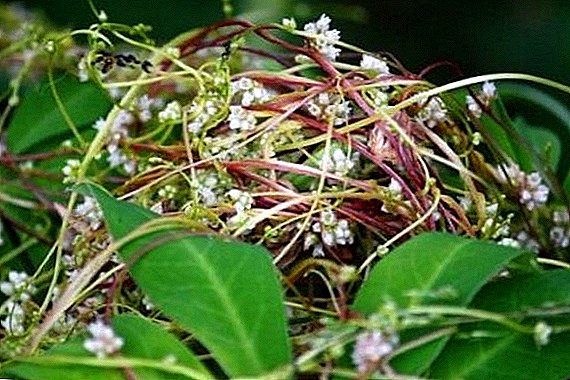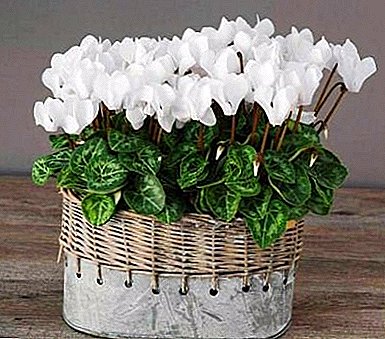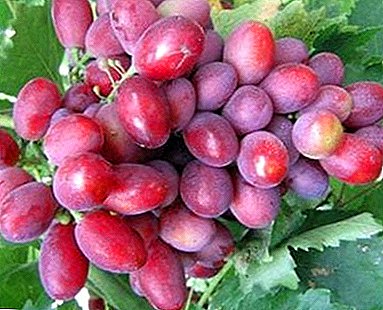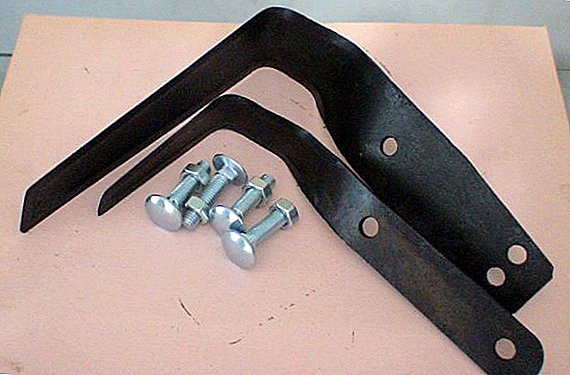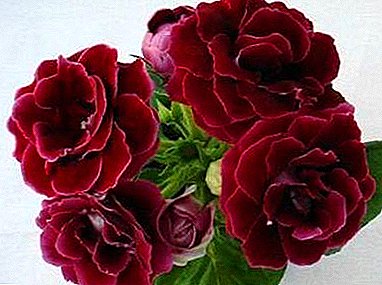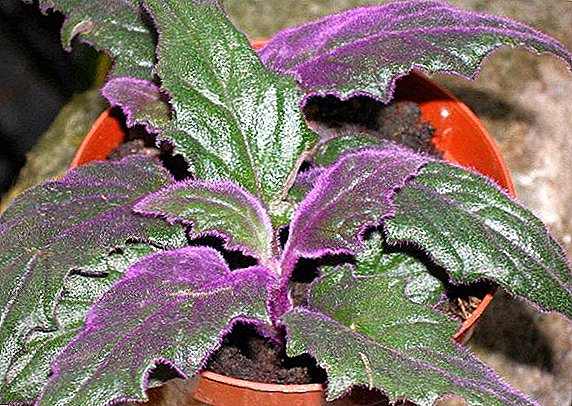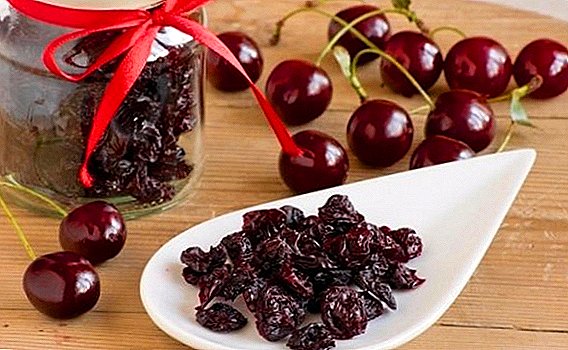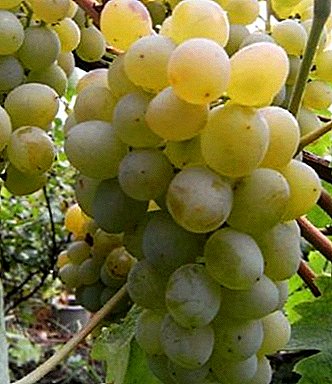 Decoration of any house or apartment are living plants. They create comfort, make the room more beautiful and alive. In our article we will talk about the main types of indoor plants and give a description of the most popular of them.
Decoration of any house or apartment are living plants. They create comfort, make the room more beautiful and alive. In our article we will talk about the main types of indoor plants and give a description of the most popular of them.
Ampelnaya plants
This species is distinguished by its unpretentiousness, so if you have never had flowers in your home, you can safely purchase a plant of this type. Representatives of this group have one thing in common - they have a long, flexible stem that creeps along the surface.
Important! As soon as the first bud appears on the ampelous flowers, it is necessary to stop all care activities, except for watering, since during this period the plant is highly sensitive and may react negatively to any intervention.Usually, walls are chosen to house such plants; they can also be fixed and hung on the window. Perfectly they look and on the shelves. Consider the most common varieties of this group.
Ampelnaya begonia
Begonia blooms for quite a long period - from early spring to late autumn. The plant has graceful bright green falling shoots, the length of which is 30-40 cm, and cascades of incredibly beautiful flowers. The first flowers appear in the 4th or 6th leaf nodule.

The life of each flower is approximately 10 days, after which new ones appear. For cultivation, you should choose a hanging basket or a vase with an extended leg. To plant pleased with abundant flowering, it is worth placing it in a sunny place.
It is possible to grow Dichondra, Surfynia, Pelargonium, Fuchsia, Nasturtium, Geranium, Bacopa, Calibrachoa, Petunia, Eschinanthus, Lobelia, Jasmine in a hanging form.
Hoya
This flower has many species, but for growing in the apartment most often choose the variety Hoya fleshy. Flower shoots reach a length of 6-7 meters. The plant has dark green leathery leaves, the surface of the foliage is glossy. Hoya is characterized by the presence of elegant white, pink, yellowish flowers, similar to asterisks.

Subject to good lighting, adult plants are pleased with abundant and long flowering. In the summer, it is not recommended to leave the flower on the window sills on the sunny side, as the foliage begins to dry and grow slowly.
It is not recommended to move the flower from one place to another, as a result of this hoya can lose foliage and lose all its buds.
In room conditions, monsteras, money sticks, cissuses, philodendrons, syngoniums, hoyas, stephanotisses, diploadii, tunbergia, room ivy, chlorofitums, Mühlenbeckia beautifully wind or wilt.
Bromeliads
The peculiarity of this group is their capriciousness to the conditions of detention, the representatives have excessive requirements for temperature indicators, air humidity. But at the same time the plants have a sophisticated look, they look very beautiful and are quite popular.
In order to achieve flowering, bromeliads must be in a room with a temperature of more than +24 ° C. It is also important to ensure good drainage and not to overdo it with watering. In hot weather, it is recommended to spray the foliage by adding liquid fertilizer to the water. Consider which bromeliad representatives are most popular.
Ehmeya striped
It has arcuate curved gray-green leaves, the length of which is about 60 cm. Silver stripes and peduncle are located on them, the appearance of which is noted only in plants aged 2-3 years. Around July, a pink inflorescence appears on the flower, which pleases the eye until December.

To bromelium, in addition to Ehmea, also include Guzmania, Vriezii, Bromelias.
Bilbergia drooping
It is represented by an epiphytic plant with narrow funnel-shaped leaf rosettes assembled in bundles. The length of the leathery leaves is 30-70 cm, they have a smooth surface and spikes on the edges, painted in dark green color. With good light, the plant blooms with pink and bronze spikelets.
 Bilbergia does not require specific care, therefore it grows well even with very busy people.
Bilbergia does not require specific care, therefore it grows well even with very busy people.
Tillandsiya blue
The height of the flower reaches 25 cm. The plant has straight leaves, which are 35 cm long and 1-1.5 cm wide. The foliage has a dark green color and the bottom is gray.
 With good lighting, indoor tillandsia will delight with buds for 2-3 years, with a lack of light it may not bloom.
With good lighting, indoor tillandsia will delight with buds for 2-3 years, with a lack of light it may not bloom.
Tillandsia possesses a direct short peduncle. The inflorescence is represented by a strongly thickened two-row spikelet, which is 16 cm long and 7 cm wide. The bracts are pink or red.
Decorative flowering
This group is the most extensive, as it includes a huge number of beautiful plants. Some of them are distinguished by the presence of berries and fruits. Everyone can choose an instance at their discretion - depending on the duration and periods of flowering. The group is divided into two subgroups:
- Potted plants are short-lived. The duration of the life cycle is usually not more than 1 year. Such a flower can be a pleasant, original gift;
- indoor plants - durable. Life expectancy exceeds one year. They can please with their flowering for several years, while not distinguished by the vagaries of care.
Indian azalea
The height of the shrub is about 50 cm. The leaves are small, painted in dark green color, they have short petioles, the dimensions of which do not exceed 3.5 cm.

Flowering occurs in the winter - at this time the azalea pleases with beautiful flowers with a diameter of 3-5 cm. They can have a bright pink, snow-white, red, purple or purple color.
Learn how to grow indoor azaleas, gerberas, chrysanthemums.Gerbera
The height of the flower is about 25-30 cm, it has elongated pubescent pinnately dissected leaves, which form a rosette. From it is the growth of single peduncles, whose diameter reaches 5 cm.

Did you know? According to the legend of the origin of the gerbera, there lived in the forest a very beautiful nymph named Gerba, which caught many admiring glances. But over time, the beauty was bored with such attention, and she turned into a modest flower - a gerbera.
There are a large number of varieties, depending on which the heart may have a different color - yellow, dark. Flowering begins in the last days of August and lasts until November. Flower petals can be red, pink, orange or yellow.
Chrysanthemum miniature
Its height can be 15-70 cm. It has smooth or slightly fleecy stems, bright leaves with a soft green color. The size of the buds can vary from 2.5 cm to 25 cm in diameter.

It is characterized by a huge number of colors of flowers: they can be white, yellow, orange, pink, lilac, two-color. The core often has a contrasting color compared to the petals.
In an effort to acquire an unusually beautiful indoor plant, pay attention to abutilon, Euphorbia Mil, asparagus, crassula, asplenium, havortiu, venus flytrap, nepenthes, staples.
Decorative leafy
Representatives of this group do not differ in special brightness, but are very popular due to the originality of the shape and color of the foliage. The decorative properties of the flower throughout the year will please the eye and refresh the interior phytodesign.
Among the specimens that belong to this group, there are both real giants and desperate crumbs. Among them there are very capricious plants, and there are handsome men without big claims to care.
Consider which flowers are particularly popular.
Anthurium Andre
A feature of this flower are short stems. The foliage has an oval-lanceolate form, the plate is 25-30 cm long, 10-12 cm wide. The cover has a wide heart shape, there is a slight wrinkling on the surface, the veins. The color of bracts is predominantly red, but may be pink, salmon, sometimes white.

Cordilina apical
It is represented by a low thin tree, the length of the leaves of which is 30-50 cm. Loss of foliage in young plants that are grown indoors does not occur.

Some specimens have striped leaves and a crimson border, some are red-brown foliage and light greenish stripes. Prefers heat and high humidity.
Learn how to care for anthuriums, cordines, shefflers, dieffenbachia.Shefflera
The main feature is the presence of palmate-dissected leaves - up to 7 pieces. Due to this structure, the foliage is very similar to an umbrella. There are representatives of the same color (green color), there are also plants with a variegated color, which is distinguished by the presence of white, yellow spots and stains.

Dieffenbachia
It has beautiful leaves with a peculiar "spotted" color. The plant quickly gets rid of the old foliage located at the bottom. Sometimes it makes the flower not very attractive. To avoid falling off, it is necessary to periodically trim the tops.

Palm trees and tree
Indoor palm tree is a very beautiful and expensive plant. Unfortunately, not everyone can afford to buy it. The most spectacular part of a palm tree is its leaves, since they can have the most diverse shape.
There are narrow, straight leaves in the shape of a semicircle. We should not forget that in no case can palm leaves be plucked, as the entire plant may die as a result of removing at least one leaflet.
Important! When yellow leaves of palm trees, it is necessary to urgently increase the frequency of watering. This is especially true of the summer period - the ground should always be wet.Indoor tree plants are able to decorate your home and create a special atmosphere in it. In addition to the beautiful appearance, they are convenient because they can be grown in the shade - they are absolutely not demanding to the presence of sunlight.
Consider the most common types of indoor palms and tree plants.
Date palmate
It has a spectacular appearance and fits perfectly into any interior. The height of palm trees grown in indoor conditions is 2 meters. It is characterized by the presence of a large number of thin bright green leaves and a thick shortened trunk.

At home, they grow a date palm, Hovey, Rapis, Cicas, Chrysalidocarpus, Pandanus, Dracene, Pachypodium, Cordilina Hamedorei, Liviston.
Yucca
It is characterized by the presence of a ligneous, small-growth, non-branching stem. It has large, rigid, sword-shaped leaves, which are assembled into dense rosettes and are colored in dark green.

Inflorescences are represented by wide-spread panicles, the length of which can reach 2 meters. In summer, the plant needs abundant watering and high humidity.
Among the most popular indoor trees emit ficuses, Dieffenbachia, boxwood, laurels, Hovei, dracaena, sweeties, abutilony, hibiscus.
Liviston
A special feature of palm trees are fan-shaped leaves and a graceful fibrous stalk, on which there are scars and vaginal petioles. Plant height averages 1.5-2 meters. Foliage has a bright green color.

At the edges of the petioles there are thorns. Care is to maintain a high level of humidity in the room, since the ends of the leaves will dry out with dry air and the plant may eventually die.
Ferns
Today, ferns can be found in almost any office space or apartment building. They refresh the interior, give it austerity. Classic ferns are represented by a rosette with dissected curved leaves, but there may be specimens with lanceolate foliage.
Virtually all ferns need moist, cool air. Consider the most popular plants from this group.
Adiantum transparent
Plant height is 25-40 cm, at the base there are pinnate or double pinnate leaves. The foliage is divided into several orders: the first has a width of up to 3 cm and a length of up to 20 cm, the second has a width of up to 1 cm and a length of up to 1.5 cm.

It is characterized by wide oval bare leaves, painted in a dull green color. The scape is rather thin, its length is up to 20 cm.
Asplenium Onionaceous
It is a deciduous herbaceous fern. It has three-pinnate foliage, which has an oblong-triangular shape, the length of the foliage is 30-60 cm, width is 20-30 cm. They have a light green color.

The plant is characterized by the presence of a straight dark petiole 30 cm long. On the surface of the foliage, the presence of brood buds can be seen.
Popular as houseplants are ferns polyrales, nephrolepis, polypodia, aspleniums, adiantum, thychos.
Phyllis
It has a short straight rhizome, on the surface of which there is a film. The width of the sheet is 4-5 cm, length - 20-40 cm. The formation of a new sheet occurs in early summer. The fern grows slowly, but is able to please the eye for a long time with its green color and interesting appearance.

Orchids
The flower attracts attention with its unusual shape, as well as thick, fleshy stems. In some species, they may be absent, which gives the plant another highlight. Some types have long sheets with a spherical, pear-shaped or elongated bulba.
But the bud itself can have very small sizes - like a pinhead or a large large kitchen plate. It is similar in shape to insects, birds, or animals. The height of the indoor flower - 30-45 cm.
Did you know? Orchids are the leaders among the flowers for the number of seeds: about 4 million can be contained in one plant.Orchid is a demanding plant, so if you decide to grow this flower, you will have to follow the recommendations of professionals. Consider the most common types of orchids.
Cattleya guba
Refers to the largest representatives of indoor orchids, but sometimes there are instances and smaller. The variety has a beautiful flower with petals, on which there is a wax coating and corrugated "lip".

The flower can live up to three weeks and has the most diverse colors - ranging from soft pink and ending with rich purple tones.
The variety of orchid species is striking - Phalaenopsis, Cymbidium, Dendrobium, Lady's Slipper, Cumbria, Miltonia, Miltoniopsis, Ludizia, Blétilla, Celogina, Wanda, Oncidium.
Orchid Cymbidium
The variety is resistant to stress, does not need special care. It is characterized by the presence of hanging flower stalks, on which there are about 10-13 orchid flowers. The colors are also very diverse - it can be a white or bright orange. Orchid bloom lasts 8-10 weeks.

Darwin Orchid
It is a representative of miniature hybrids with dark, leathery leaves and elegant inflorescences, in which there are small blue-violet flowers with a diameter of 2-3 cm. The inflorescence has a racemose shape, it contains about 7-12 flowers.

Fruiting indoor plants
If you want to find a plant for cultivation that will not only please the eye, but also be useful, you should pay attention to the group of fruit-bearing ones. Of course, it will not be easy to grow such an exotic tree, but if you wish, you can plant a tea tree, avocado or pineapple at home. However, there is no guarantee that they will take root and yield a crop.
If you still decide to try to compete for a fruiting plant, we suggest that you familiarize yourself with the most common ones.
Lemon Room
Presented mainly dwarf plants, the probability of fruiting in the apartment is quite high. In one year, about 10–20 lemons can be harvested from a tree.

The fruits have a bright color, and the tree itself has an extraordinary fragrance. The appearance of the fruit mark only the 3-5th year after planting.
A pineapple
In the cultivation of pineapples is nothing complicated. To obtain planting material, the top of the head with the leaves of the fruit is cut off and rooted in a special mixture that contains peat and sand, covered with a plastic bag.

After some time, the rooted plant is transplanted into the soil, which contains leaf humus, soddy soil and sand. For planting is to choose a large pot - only in this case, you can get the fruit.
The optimum temperature for the pineapple tree is +25 ° C.
Room orange
It belongs to a dwarf variety of plants, it needs almost the same growing conditions as it does for a lemon. The only difference is that it is better not to leave the tree under direct sunlight.

Room orange is a moisture lover, so it is recommended to spray in the heat, and in the winter only watering should be done.
Important! In order to form a uniform crown of a room orange, it is necessary to periodically turn the pot so that sunlight will fall on the whole tree.To give a beautiful shape to an orange, it is worth performing its pruning, otherwise it may grow disproportionately. But in order to harvest the first crop, the tree will have to be planted from the plant that bears fruit.
Cacti
Cacti are a special group among all houseplants, as they have a special appearance and need little other conditions. A special feature of cacti is that they do not have leaves, more precisely, they are represented by thorns, and the stems are responsible for photosynthesis.

Also, all cacti have an areola - a modified axillary bud, which is a growing point. In the wild, due to the presence of thorns, plants protect themselves from predators and from the sun. Therefore, the more spines a cactus has, the longer it will be able to live under the scorching sun.
Today, there are a huge number of cacti species that are suitable for home cultivation. We offer to get acquainted with some of them.
Woolly woolly
The peculiarity of this cactus is the presence of unusual whitish woolly pubescence. Flowering occurs quite rarely. Plant height reaches 35-70 cm.

There is a columnar strong and rather thick stem, painted in green and gray. The surface is covered with sharp spines and hairs.
Mammillaria, tsereusy, ripsalisa, epiphyllum, echinocactus, opuntia, hymnocalycium are popular for growing at home.
Rebution
It is a miniature plant whose stem is a flattened ball. Hillocks are located across the surface. The plant has about 5 light central spines, as well as a large number of soft.

The first flowering occurs only in the 2nd year. Flowers can be light red, deep yellow, purple or orange. After the end of flowering on the cactus you can see the fruits of pale green color.
Cactus parody
It is characterized by the presence of a short stem, resembling a cylinder or a ball, on which spiral ribs are located. On them are bumps with areoles and a dense edge. Each areola contains 1-5 spines with a length of 4 cm, 10-40 short ones with a barbed length of 0.5-1.5 cm. It begins flowering at an early age.
Succulents
This group of plants is great for those flower growers who are just starting to grow plants. Succulents unpretentious in the care, reproduction occurs quite easily and quickly.
The main thing is to place the flower in a sunny place, regularly ventilate the room and make high-quality drainage. A characteristic difference in this group is the shape of the leaves and their sizes.
Consider the most popular types of succulents.
Agave
The plant has hard dense leaves, painted in green and dark green color, having yellowish stripes. The growth of foliage occurs from the central leaflet in a circle.

Agave feels comfortable at an air temperature of + 8 ... +21 ° С. It is recommended to water the flower every 3-4 weeks.
Popular succulents are also aichriones, havortias, lithops, aloe, kalanchoe, nolinae, epiphyllums, adeniums.
Brigamia
Succulent is characterized by the presence of a tree trunk, dark green large leaves. It is able to withstand high temperatures with ease, but in winter you should not allow it to fall below +15 ° C.

The plant needs high humidity and regular spraying of the foliage. It is recommended to feed brigamium phosphate fertilizers. Flowering occurs in the winter months.
Dorstenia
It has a tree trunk and long, narrow light green leaves. Loves heat, needs good lighting and not too high humidity. Watering in the summer period costs 3 times a month, in the winter - every three weeks. Drestenie flowers have similarities with the boxes, painted in green. 
Predatory
A distinctive feature of the representatives of this group is that they love to feast on various insects. Due to the pleasant smell, it is easy for such plants to attract a "victim". As soon as the insect touches the leaflet, the predator immediately starts its digestion.
Learn more about carnivorous plants.
In addition, predators have the ability to distinguish the real food from the inedible object: if it falls, it will continue to search for this dinner. Today there are only 630 species of predatory plants. We suggest to get acquainted with the most common.
Venus flytrap
The foliage is represented by an open sink, on the edges of which there are elongated strong teeth. On the foliage there are hairs with high sensitivity, which are necessary for the predator in order to sense the approach of the insect.

As soon as mining is approaching, the leaf leaves slam instantly and it is no longer possible to open them. The predator digests its prey for several weeks. In summer, the trap has a bright color, its size is 3 cm.
Sarracenia
Differs very bright flowers. Even in the absence of flowering predator is clearly visible. The leaves are painted in emerald color, have a fancy shape, on their surface there is a thick grid of crimson veins, from which the sweet juice flows.

Nepentes
The foliage has a tubular shape, similar to water lilies. Inside the leaves with cells, nectar is released. In the same place are the hairs pointing down.

On the inner wall there is a wax coating, which helps insects directly into the water lily. Because of the slippery surface and hairs, the victim cannot get out of the trap. As a result, it simply sinks and decomposes.
Did you know? The fastest predator among the flowers is the pemphigus. Her trap can drag a victim in less than one millisecond.Due to the huge variety of indoor plants, each grower can choose a copy to his liking. By following the recommendations for care, you can make your home more comfortable thanks to the beautiful and unusual colors.



